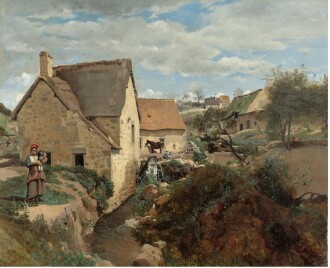Works by Jean-Baptiste-Camille Corot at Sotheby's
Jean-Baptiste-Camille Corot Biography
Jean-Baptiste-Camille Corot, often referred to simply as Camille Corot, was a highly successful French painter who is perhaps most notably known for establishing the landscape genre as independently valuable, and for prefiguring Impressionism. Born in Paris in 1796 to middle-class parents, Corot dedicated his life to his art at the age of 25, after failing to prove himself in either academia or his fathers trade in the milliner business. His devotion to painting was so intense that he proclaimed to a friend of his commitment, “This firm resolve will stop me forming any serious attachments. That is to say, I shall not get married.” He was never, in fact, married, and there is no evidence to suggest he ever had a serious romantic liaison.
Although Corot’s life was punctuated by travel throughout the continent, namely Italy where he would travel several times, Corot maintained an artistic practice that was routine and timed with the seasons. Preferring to work en plein air, he would spend his springs and summers working outdoors in nature completing countless oil sketches and drawings. When the weather would turn in late fall and winter, he would withdraw to his home studio to work on large canvases based on the studies he had done in the previous months.
Landscapes were Corot’s subject of choice, and although he would occasionally include small figures to appease certain academic tastes for historic or allegorical themes, he preferred a genre that he invented: Souvenirs. Unlike works based on a specific location, these were somewhat more generic and composed of standardized motifs like a lake, wooded clearing, or combination of natural elements drawn from his imagination rather than reality. His paintings are masterful in their subtle use of tonality, and their overall melancholic, even nostalgic, air; this might be in no small part inspired by the Industrial Revolution, the effects of which cannot be seen anywhere in his oeuvre.
Although Corot achieved middling success early in his career, it was in 1840 when the government of France purchased one of his works, and, five years later, when he received a glowing review from the famed poet Charles Baudelaire that his career took off. He was made a member of the Legion of Honor in 1846 (and later was promoted to officer within the Legion in 1867), won a first place medal for painting at the 1855 Paris Universal Exposition, and ultimately became so sought after that his supply did not meet demand—leading him to be one of the most copied and forged artists of his time.
Despite his growing fame, Corot lived conservatively and preferred the company of fellow painters. He was particularly close with the Barbizon group, befriending other painters such as Jean-François Millet and Théodore Rousseau. He also generously taught younger painters, such as Camille Pissarro who would go on to be an integral figure of the Impressionist movement.
Corot died in 1875, but the importance of Corot’s painting within the trajectory of modern art has not diminished, even today. His works can be found in nearly all the leading art museums globally, including the Phillips Collection, Washington, DC; the Musée du Louvre, Paris; and the Pushkin Museum, Moscow.
Read Less











